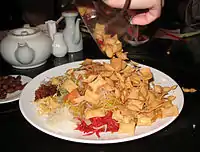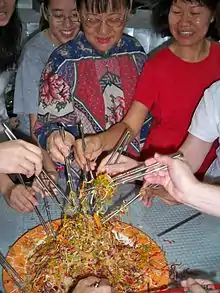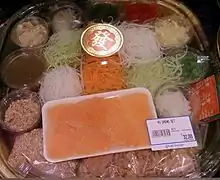Yusheng
Yusheng, yee sang or yuu sahng (Chinese: 魚生; pinyin: yúshēng; Jyutping: jyu4saang1), or Prosperity Toss, also known as lo sahng (Cantonese for 撈生 or 捞生) is a Cantonese-style raw fish salad. It usually consists of strips of raw fish (sometimes salmon), mixed with shredded vegetables and a variety of sauces and condiments, among other ingredients. There is also a vegetarian version of this dish, where the fish is replaced with soy "fish", which resembles salmon. Yusheng literally means "raw fish" but since "fish (魚)" is commonly conflated with its homophone "abundance (余)", Yúshēng (魚生) is interpreted as a homophone for Yúshēng (余升) meaning an increase in abundance. Therefore, yusheng is considered a symbol of abundance, prosperity and vigor.
| Alternative names | Lou Sang, Yee Sang, Yu Sheng, Jyu4 Saang1, Lo Hei, Prosperity Toss |
|---|---|
| Place of origin | Malaysia[1] |
| Main ingredients | Raw fish (or soy fish for the vegetarian version), shredded vegetables and a variety of sauces and condiments |
| Other information | Consumed during Chinese New Year |


While versions of it are thought to have existed in China, the contemporary version was created and popularised in the 1960s amongst the ethnic Chinese community and its consumption has been associated with Chinese New Year festivities in Maritime Southeast Asia.
Today, the common form of yusheng is the qicai yusheng (七彩鱼生; "seven-coloured raw fish salad") served in local restaurants during the Chinese New Year period. Also referred to as facai yusheng (发财鱼生; "prosperity raw fish salad") or xinnian yusheng (新年鱼生; "Chinese New Year raw fish salad"), this present colourful take on yusheng has an uncertain origin. However, there are two competing claims to the origins of the modern take on yusheng: first was said to be invented by a Malaysian named Loke Ching Fatt in Seremban, Malaysia in the 1940s; second was said to be created in the 1960s by chefs Lau Yoke Pui, Tham Yui Kai, Sin Leong and Hooi Kok Wai, together known as the "Four Heavenly Kings" in the Singapore restaurant scene. The recipe generally includes ingredients such as shredded white and green radish and carrots, ginger slices, onion slices, crushed peanuts, pomelo, pepper, essence of chicken, oil, salt, vinegar, sugar and more.
History
The Chinese China Cuisine Association mentions the tradition coming from Guangdong, China before the dishes were brought to Southeast Asia by Chinese immigration.[2] However, the statement only mentions the tradition of having raw fish during Chinese New Year, which was served very differently from today's Yusheng. [2]
According to the local newspapers, Yusheng is a dish invented by Lu Zhen Ji (陆祯记), a Chinese restaurant in Seremban, Malaysia in the 1940s. The owner of the restaurant told the newspaper the dish was inspired by a fish noodles dish from Guangdong, China. [3] However, Singaporeans believe the dishes were invented by four chefs in the 1960s. [4] The descendants of Lu Zhen Ji mention that the origin of the dishes is hard to prove due to lack of proper records and asked the public to stop the conflict between the two countries. [5]Eating Yusheng during Chinese New Year is a cultural activity for Chinese living in Malaysia, but not so much in other Chinese-populated regions such as Hong Kong, where the practice is almost unheard of .
It was modified by 4 master chefs in 1964 in a restaurant kitchen in Singapore. It made its Singapore debut during Lunar New Year of 1964 in Singapore's Lai Wah Restaurant (Established in Sept. 1963).[6] The 4 master chefs were Than Mui Kai (Tham Yu Kai, co-head chef of Lai Wah Restaurant), Lau Yoke Pui (co-head chef of Lai Wah Restaurant), Hooi Kok Wai (founder of Dragon-Phoenix Restaurant, established on 8 April 1963) and Sin Leong (founder of Sin Leong Restaurant) who, together created that as a symbol of prosperity and good health amongst the Chinese.[7]
In the 1970s, Lai Wah Restaurant started the modern-day method of serving yusheng with a pre-mixed special sauce comprising plum sauce, rice vinegar, kumquat paste and sesame oil – instead of customers mixing inconsistently-concocted sauce.[8]
However, the Malaysian Chinese dispute the origins of this dish, so much that the dish was declared Malaysian heritage food by the Malaysian Department of National Heritage.[9] One thing that is certain, though, is that this dish has its roots deep in the Southern part of China.[10]
Ingredients and their symbolism

When putting the yusheng on the table, New Year greetings are offered. Some of the phrases commonly used are:
- 恭喜发财 / 恭喜發財 (pinyin: gong xi fa cai; Jyutping: gung1 hei2 faat3 coi4) meaning "Congratulations for your wealth"
- 万事如意 / 萬事如意 (pinyin: wan shi ru yi; Jyutping: maan6 si6 jyu4 ji3) meaning "May all your wishes be fulfilled"
The fish is added – its Mandarin word, "魚" corresponds to a homophone of it "余 / 餘" meaning "abundance", thus 年年有余 / 年年有餘 (pinyin: nian nian you yu; Jyutping: nin4 nin4 jau5 jyu4), "abundance through the year". Pomelo or lime (大利, dali / daai lei) is added to the fish, adding luck and auspicious value (大吉大利 pinyin: da ji da li; Jyutping: daai6 gat1 daai6 lei6, meaning "good luck and smooth sailing"). Pepper is then dashed over in the hope of attracting more money and valuables. 招财进宝 / 招財進寶 pinyin: zhao cai jin bao; Jyutping: ziu1 coi4 zeon3 bou2 meaning "Attract wealth and treasures". Then oil is poured out, circling the ingredients and encouraging money to flow in from all directions – referring to 一本万利 / 一本萬利 pinyin: yi ben wan li; Jyutping: jat1 bun2 maan6 lei6, meaning "make 10,000 times of profit with your capital", and 财源广进 / 財源廣進 pinyin: cai yuan guang jin; Jyutping: coi4 jyun4 gwong2 zeon3 meaning "numerous sources of wealth".
Carrots are added indicating blessings of good luck: the first word in the compound word representing the ingredient, "红萝卜 / 紅蘿蔔" (pinyin: hong luo bo; Jyutping: hung4 lo4 baak6), 红 / 紅 (hong / hung) has a homophone in 鸿 / 鴻 referring to 鸿运当头 / 鴻運當頭 pinyin: hong yun dang tou; Jyutping: hung4 wan6 dong1 tau4 meaning "good luck is approaching". Shredded green radish is later added symbolising eternal youth – 青春常驻 / 青春常駐 pinyin: qing chun chang zhu; Jyutping: cing1 ceon1 soeng4 zyu3, "forever young". After which the shredded white radish is added – prosperity in business and promotion at work (风生水起 / 風生水起 pinyin: feng sheng shui qi; Jyutping: fung1 saang1 seoi2 hei2 – "progress at a fast pace", 步步高升 pinyin: bu bu gao sheng; Jyutping: bou6 bou6 gou1 sing1 – "reaching higher level with each step").
The condiments are finally added. First, peanut crumbs are dusted on the dish, symbolising a household filled with gold and silver (金银满屋 / 金銀滿屋 pinyin: jin yin man wu; Jyutping: gam1 ngan4 mun5 uk1, meaning "household filled with gold and silver"). Sesame seeds quickly follow symbolizing a flourishing business (生意兴隆 / 生意興隆 pinyin: sheng yi xing long; Jyutping: saang1 ji3 hing1 lung4, meaning "prosperity for the business") Yu Sheng sauce, usually made from plum sauce, is generously drizzled over everything – a reference to 甜甜蜜蜜 pinyin: tian tian mi mi; Jyutping: tim4 tim4 mat6 mat6, meaning "may life always be sweet"[11] Deep-fried flour crisps in the shape of golden pillows is then added with wishes that literally the whole floor would be filled with gold (遍地黄金 / 遍地黃金 pinyin: bian di huang jin; Jyutping: pin3 dei6 wong4 gam1, "floor full of gold").
Modern version of the dish
The yusheng had fish served with daikon (white radish), carrots, red pepper (capsicum), turnips, red pickled ginger, sun-dried oranges, key lime leaves, coriander, chilli, jellyfish, chopped peanuts, toasted sesame seeds, Chinese shrimp crackers (or fried dried shrimp), five spice powder and other ingredients, laced with a sauce using plum sauce, rice vinegar, kumquat paste and sesame oil, for a total of 27 ingredients.[12][13][14] Originally, the dish used raw wolf herring, although salmon was later offered as an alternative due to said species' growing popularity with customers.
Serving
Yusheng is often served as part of a multi-dish dinner, usually as the appetizer due to its symbolism of "good luck" for the new year. Some would consume it on Renri, the seventh day of the Chinese New Year, although in practice it may be eaten on any convenient day during the Chinese New Year period (the first to the 15th day of the first lunar month).
The base ingredients are first served. The leader amongst the diners or the restaurant server proceeds to add ingredients such as the fish, the crackers and the sauces while saying "auspicious wishes" (吉祥话 / 吉祥話 pinyin: jíxiáng huà; Jyutping: gat1 coeng4 waa6*2) as each ingredient is added, typically related to the specific ingredient being added. For example, phrases such as 年年有余 / 年年有餘 (pinyin: niánnián yŏuyú; Jyutping: nin4 nin4 jau5 jyu4; "may there be abundance year after year") are uttered as the fish is added, as the Chinese word for "surplus" or "abundance" (余 / 餘 pinyin: yú; Jyutping: jyu4) sounds the same as the Chinese word for "fish" (鱼 / 魚 pinyin: yú; Jyutping: jyu4).
All diners at the table then stand up and proceed to toss the shredded ingredients into the air with chopsticks while saying various "auspicious wishes" out loud, or simply "lo hei, lo hei" (撈起, 撈起 pinyin: lāoqǐ, lāoqǐ meaning "scoop it up, scoop it up"). It is believed that the height of the toss reflects the height of the diners' growth in fortunes, thus diners are expected to toss enthusiastically.
See also
References
- https://sea.mashable.com/article/2426/malaysians-are-pissed-because-bbc-linked-yee-sang-to-rivals-singapore
- ""鱼生"到底源自哪一国·都市快报". hzdaily.hangzhou.com.cn. Retrieved 2021-01-29.
- "捞生是大马人发明.鱼生2009年已列国家文化食品". www.sinchew.com.my. Retrieved 2021-01-29.
- "本地广东人捞鱼生传统 始于40年代". 早报 (in Chinese). 2017-02-04. Retrieved 2021-01-29.
- "七彩鱼生创办人后裔 陆兆福与森王室成员捞生". www.enanyang.my (in Chinese). 2020-05-26. Retrieved 2021-01-29.
- Ref : i-weekly issue 669 26 Min Daily 15 Feb 2003 Page 24 Lian He Wan Bao 17 Feb 1996 Page 34 YUAN publisher = Singapore Federation of Chinese Clan Associations date = 2003-02-01
- Ref: Sundays Times-18th Feb 2007
- Ref : Sin Chew Jit Poh 27 Jan 1979 Page 11 YUAN publisher = Singapore Federation of Chinese Clan Associations date = 2003-02-01
- "Intangible Heritage Objects". Archived from the original on 2015-04-02.
- "撈生出處掀爭議‧陸志就:無人能證實撈生來源‧芙蓉40年代已有魚生". Sin Chew Jit Poh. Sin Chew Jit Poh. 30 January 2012. Archived from the original on 22 February 2015. Retrieved 22 February 2015.
- "Recipe: DIY Homemade Yu Sheng Sauce for Chinese New Year". The Moonberry Blog. Retrieved 25 November 2014.
- "Singapore celebrates New Year". News24/Reuters. 2008-02-05. Archived from the original on 2008-02-08. Retrieved 2008-02-05.
- Huang, Lijie (2006). "It's a toss up". ST Foodies Club. Singapore Press Holdings. Archived from the original on 2008-02-09. Retrieved 2008-02-05.
- "Archived copy". Archived from the original on July 10, 2006. Retrieved January 31, 2006.CS1 maint: archived copy as title (link)
External links
| Wikimedia Commons has media related to Yusheng. |
- Interactive Virtual Reality – Process of Lo Hei
- Jack Tsen-Ta Lee, A Dictionary of Singlish and Singapore English – lo hei
- Jack Tsen-Ta Lee, A Dictionary of Singlish and Singapore English – yusheng
- A recipe for yusheng
- DIY Spring Toss Yusheng recipe
- How to toss Yee Sang (video)
- Yusheng Ingredients Meaning